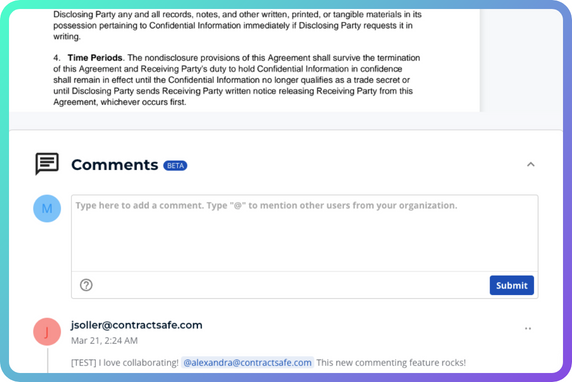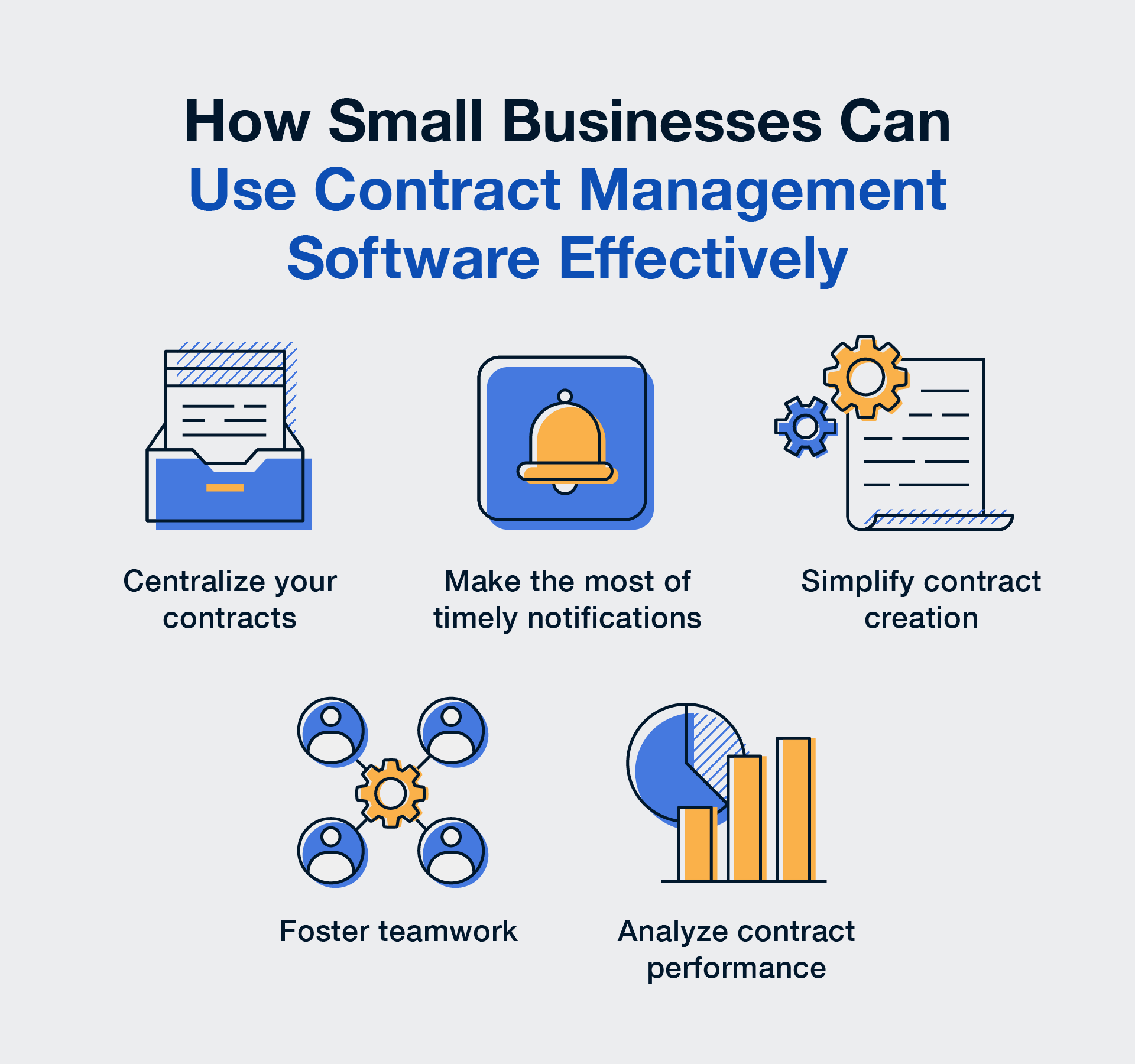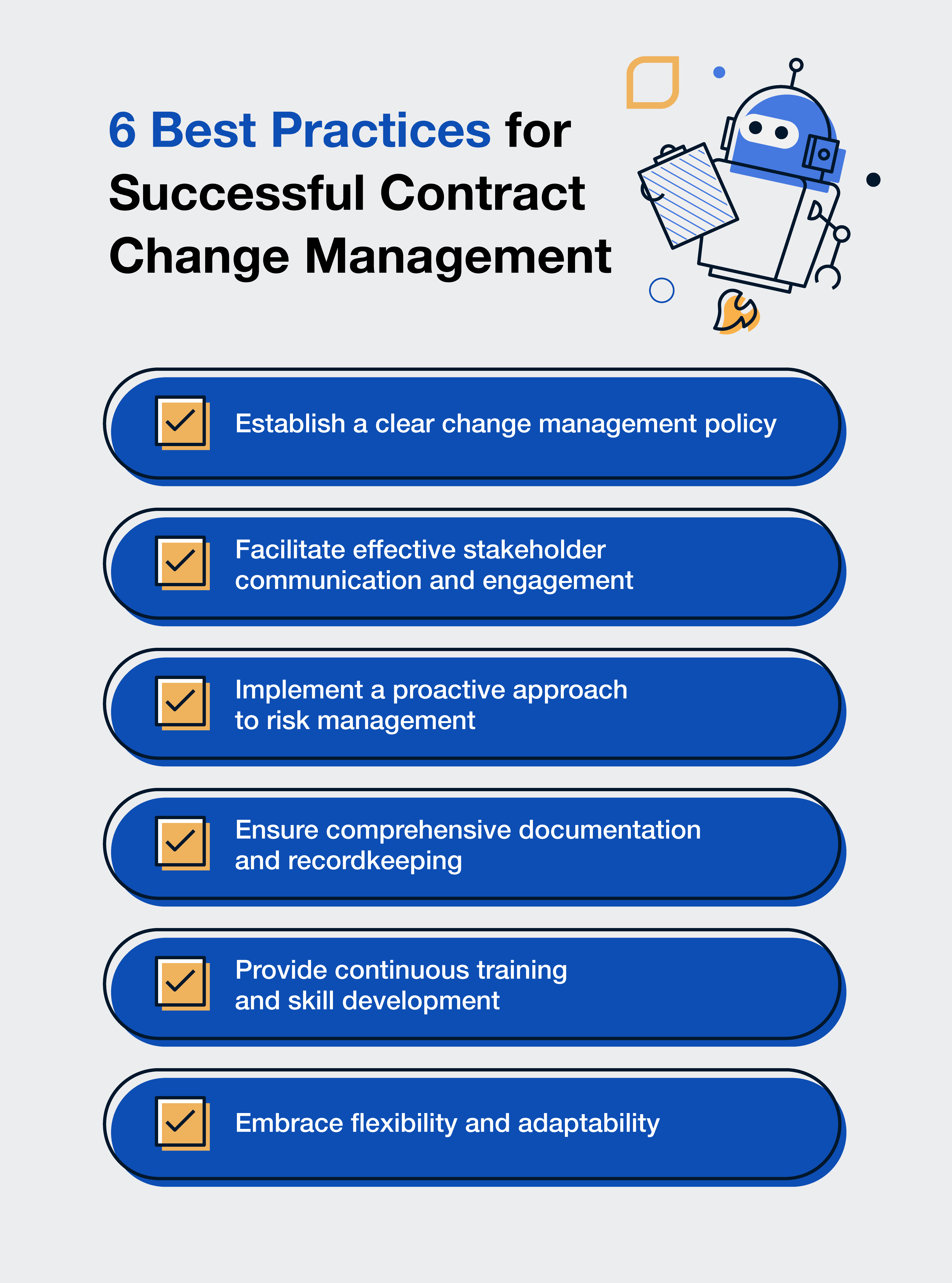In business, change is the only thing you can count on. And it's especially true in contract management. Contracts change, and managing those changes is how your business stays ahead.
Contract change management is a critical skill in today's evolving business environment because, as we’re sure you know, the fun is just getting started once you execute a contract.
This simple guide will cover the basics of contract change management, some challenges you might face, best practices to follow, and how contract management software can help.
TL;DR
- Adaptability is key in businesses of any size, and contract change management is at the heart of it. Stay ahead by keeping your contracts flexible and up-to-date.
- Expect the unexpected. Delays, budget adjustments, and legal complexities are part of the journey. Being prepared makes all the difference.
- The power trio for handling contract changes effectively: well-defined policies, proactive risk management, and the strategic deployment of contract management software.
What Is Contract Change Management?
Contract change management is the process of managing changes or modifications to existing contracts. This process is crucial when responding to unexpected business developments, regulatory changes, or shifts in strategic direction. It ensures that contracts remain relevant, enforceable, and reflective of current business realities.
Changes can happen for various reasons:
- Shifting scope: Maybe the project's goals or what you need to deliver has changed. These adjustments mean you need to update your contract to match the new plan.
- Market dynamics: Market conditions aren’t static. If there is a significant shift, you might need to revise your contracts to keep up with the new economic landscape.
- Legal or regulatory changes: Regulations reflect the world they rule. Change is unavoidable, and contracts need to change as new laws and regulations pass.
- Organizational changes: Mergers, acquisitions, or pivots in strategy can greatly impact a business. It's important to revise your contracts to reflect these new realities.
- Performance challenges: Sometimes, the issue is about how well each side meets the contract terms. If one party is not meeting the contract terms or they're doing much better than expected, the contract might need an update. This helps keep everything fair and clear for everyone involved.
Whether it's a small tweak or a major overhaul, managing these changes well can make a huge difference. It keeps your contracts strong, making sure they reflect what's happening in your business and the world around it.
How To Change a Contract
Changing a contract might seem tricky, but you just need to follow a few simple steps:
- Notification of change: Before diving into the details of a contract change, it’s helpful to have a system in place for how the contract team is notified about the need for a review. This could be triggered by internal requests, external factors, or periodic reviews set by company policy.
- Identify the contract issue: Once notified, the next step is to thoroughly review the contract to pinpoint exactly what's not working or what needs changing. Sometimes, the issues aren't obvious, so take your time to review everything carefully.
- Assess and prioritize: Once you know the problem, think about the severity. Is it something that needs to be fixed right away, or can it wait? This step will help you decide how urgently you need to act.
- Develop a solution: This is where teamwork comes in. Sit down with the people involved and come up with a plan. This means communicating and negotiating with stakeholders and counterparties to solve the issue in a way that works for everyone.
- Document and approve: Now it’s time to get everything in writing. Create a clear document that explains what changes you want to make, why, and how long the changes will take to implement. Then, you need to show this document to the right people — maybe a manager or a legal team — for their approval.
- Implement and monitor: After getting the green light, put those changes into action. Keep an eye on how things are going with the new terms so you can make sure the changes are doing what they're supposed to do.
Pain Points in Contract Change Management
While changing contracts is necessary, it's not always easy. Being ready for the contract management challenges makes a big difference.
Here are some common hurdles you might face:
Keeping the contract's spirit: It's important to make sure that changes don't stray too far from what the contract was originally meant to do. The challenge is to update the terms while keeping the contract's main purpose and value intact.
Balancing different interests: Contracts involve more than one party, and everyone has their own goals and needs. Finding a middle ground where everyone's happy can be tough, but remember that respect and understanding can go a long way in maintaining a fruitful business relationship.
Complying with laws and regulations: Every time you change a contract, it has to line up with the law. This can be tricky, especially when laws and regulations keep changing. You need to make sure every update is legal and doesn't cause any new problems.
Handling new risks: Changing a contract can bring new risks. It's about spotting these risks early and finding ways to deal with them. This means thinking ahead and being ready for what might come up.
Dealing with these challenges is part of keeping your contracts in good shape. It might seem tough, but with the right approach and preparation, you can manage these changes smoothly and preserve the value of your contract.
6 Best Practices for Successful Contract Change Management
Planning for the challenges of contract change management is crucial, but it's just one part of the picture. To really master this process, there are some best practices you should follow.
These practices will not only help you deal with changes more easily but also ensure your contracts continue to serve your business well.
1. Establish a Clear Change Management Policy
A clear policy for changing contracts can help guide everyone on what to do and how to do it. This policy should be well-thought-out and cover everything from starting a change to getting it approved.
Here’s what to include:
- Initiating changes: Clearly state who can begin the process of changing a contract and under what circumstances. This sets the stage for a structured approach to initiating changes.
- Reviewing changes: Detail the steps for thoroughly reviewing proposed changes. This ensures every proposed modification is considered carefully and critically.
- Approving changes: Define who has the authority to give the final approval for changes. This clarity helps in making the process transparent and accountable.
- Roles and responsibilities: Specify who is responsible for each part of the change process. This clarity helps prevent overlap and confusion.
- Criteria for significant changes: Establish what counts as a significant change. This helps in prioritizing and managing larger, more impactful modifications more effectively.
- Documentation and recordkeeping: Emphasize the importance of documenting each step, from the initial proposal to final approval. This is crucial for audits, future reference, and maintaining transparency.
- Communication plan: Outline how changes will be communicated to all relevant stakeholders. Effective communication is key to ensuring everyone is on the same page.
- Review and update mechanisms: Include a strategy for regularly reviewing and updating the policy itself. This ensures your change management policy stays relevant and effective in the face of business evolution, legal changes, and market shifts.
Having some basic guidelines and a contract workflow in place makes the whole process smoother. It sets a standard way of doing things and guarantees that every change is handled the right way, every time.
2. Make Sure Your Records Are Up-to-date
Think of maintaining your contract records as keeping a detailed log of your business journey. It's all about knowing where you've been to understand where you're heading.
- Start with a simple, organized approach. Store every version of your contracts in one central place. This way, you have a complete narrative of each contract's evolution, all in one easily accessible location.
- Keep track of the latest active version of your contract. Digital tools are great for this, giving you immediate access to the most current version and helping prevent any confusion, as well as highlighting any changes, comments or tags along the way.
- Remember the who, why, and when of each contract change. If you're using a system like ContractSafe, you're in luck. It allows you to attach all related documents and past versions directly to the main contract and doesn’t even count against your contract limit.
- Don't forget about security and accessibility. With modern cloud-based repositories, your contracts are not only well-protected but also readily available whenever you need them.
By following these tips, you'll ensure that your contract records are always clear, organized, and within reach, making your contract management process smoother and more efficient.
3. Maintain Clear Lines of Communication
Smooth management of contract changes relies heavily on how well you communicate with everyone involved. It’s crucial to keep all stakeholders in the loop from the start.
When there are proposed changes, let everyone know quickly. Be clear about why these changes are needed and what they involve. This will lead to better, more inclusive decisions and can prevent misunderstandings or disagreements down the line.
Collaborative contract management software is great for this. It can help you share information easily and gather feedback efficiently, thanks to built-in alerts and reminders and approval workflows.
Regular meetings and updates are also important to keep everyone on the same page and move things along smoothly.
By regularly updating everyone involved and encouraging open dialogue, you can reduce resistance to changes and foster a more cooperative environment where everyone has a say in the process. In turn, this can lead to more effective and successful contract change management.
4. Create a Single Source of Truth for Contract Knowledge
Equip your team with the latest and greatest contract management knowledge by hosting regular training sessions. It’s an ever-evolving field, so this training can help everyone stay on top of their game.
- Centralized training materials: Make sure everyone on your team is trained and aware of how to use your contract management system (CMS). It’s vital that they know this system is the go-to place for the most up-to-date contract information. The file on someone's desktop from six months ago just won't cut it anymore.
- Host regular training sessions: Training should not just cover the nuances of contract management but also go into detail on how to effectively use your CMS. These sessions can be done online or even in 'lunch and learn' events.
- Invest in ongoing skill development: Allocate resources for further development of your team’s skills. This could involve attending industry conferences, participating in webinars, or providing access to in-depth learning materials. Focus on equipping your team to not only understand the intricacies of contract changes but also to be adept at navigating your CMS for the latest data.
Training gives your team the tools they need to succeed. When they know the latest practices and how to use new technology effectively, they’ll be ready for anything that pops up.
5. Be Proactive in Risk Management
Risks are unavoidable when it comes to contract changes. That’s why it’s so important to be proactive. Spotting potential issues early and having strategies in place to mitigate potential risks can save a lot of time, money, and headaches.
Here are some common contract change risks and how to address them:
- Delays: Contract changes can sometimes cause delays. Whether it's due to new terms or shifting expectations, planning ahead for these possibilities can keep your project on schedule.
- Overspending: Be mindful of how contract amendments might impact your costs. A thorough review of budget implications will help you adjust financial plans accordingly.
- Regulatory blowback: Ensure every contract alteration adheres to current laws. A legal review process is vital to avoid complications down the line.
- Misunderstandings: Clear and consistent communication is crucial. Ensuring everyone's on the same page about the contract's changes can prevent conflicts and confusion.
Managing risks proactively involves crafting effective solutions tailored to each situation. Whether it’s through additional reviews or enhanced communication strategies, being prepared will keep your transitions smooth and your project goals on track.
6. Embrace Flexibility and Adaptability
Being able to adapt and adjust is kind of a superpower in the business world. And when you’re managing contract changes, flexibility can make a huge difference.
Sometimes, the path from A to B is paved with quicksand, and you need to adjust your course to get to your destination safely and effectively. This could mean revising some parts of a contract or finding new ways to meet your goals when things don’t go as planned.
Creating a workplace culture that values this kind of flexibility and quick thinking is invaluable. It means everyone is more open to finding solutions when unexpected challenges pop up.
But remember, being adaptable means having the right tools and systems in place. The appropriate technology can significantly ease the process of adjusting to changes.
Leveraging Technology in Contract Change Management
Contract management software is a game-changer in handling contract changes. It brings efficiency and accuracy and makes sure you stay in line with obligations and regulations.
Here are some important features that can transform the way you handle contract changes:
- Contract repository: This feature is like a central hub for all your contracts. With just a few clicks, you can access any contract document. This centralized access is crucial not only for keeping your documents neatly organized but also for ensuring that everyone in your organization is referring to the same, most recent information. It's particularly useful during times of contract revisions, when quick access to various versions of contracts is needed, or during audits, where verifying contract integrity and history becomes vital.
- Contract tracking and version control: Manage different contract versions effectively with version control, ensuring that every amendment or update is recorded and easy to trace. This level of control means that there's less chance of confusion over which version is current, and it ensures that all parties involved are on the same page. It's especially helpful in scenarios where multiple stakeholders need to review and agree on contract changes.
- Alerts and notifications: Think of these as your personal contract assistant who never sleeps. It’ll send you timely reminders about important deadlines, upcoming renewals, or any changes that need your attention. This proactive approach to contract management means you're always one step ahead, minimizing the risk of missing critical deadlines or overlooking key contract updates. It's an essential tool for keeping the contract lifecycle smooth and uninterrupted.
- Integrations: This feature bridges the gap between your contract management and other key business processes. By integrating your contract management system with CRM (Customer Relationship Management) or ERP (Enterprise Resource Planning) systems, you create a cohesive ecosystem where information flows seamlessly between departments. This integration ensures that contract data supports wider business decisions, aligning contractual commitments with sales forecasts, financial planning, or project management.
Using these contract management tools will transform your operations, offering you greater control and insight into every change made to your contracts.
Learn How ContractSafe Can Simplify Your Contract Management Strategy
Discover the ease and efficiency of managing your contracts with ContractSafe. Our platform streamlines every aspect of contract management, from automated workflows to seamless integrations, ensuring your contracts are always up-to-date and compliant.
Ready to take the next step?
Schedule a personalized demo today and witness firsthand how ContractSafe can simplify and enhance your contract management strategy.


















